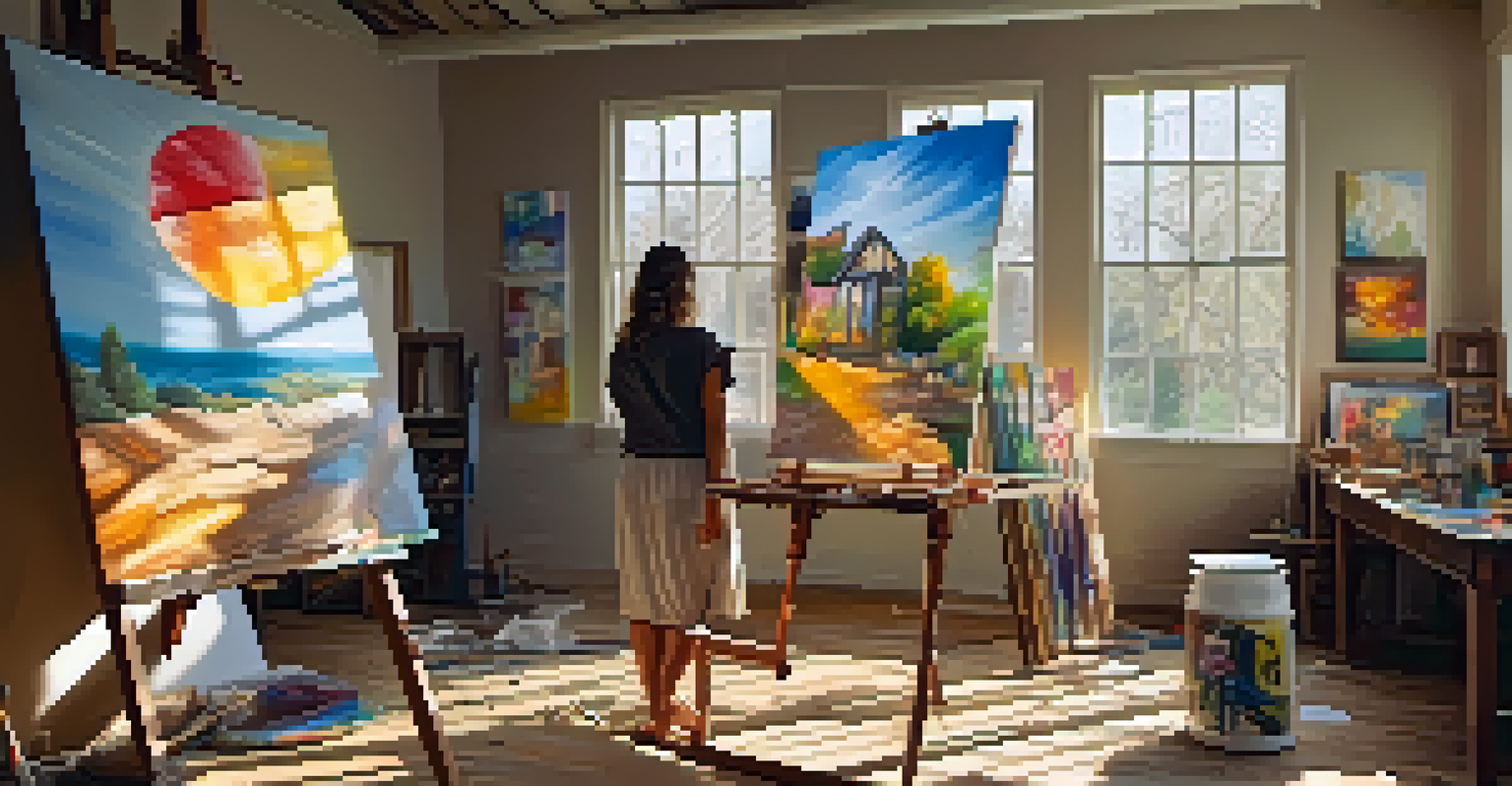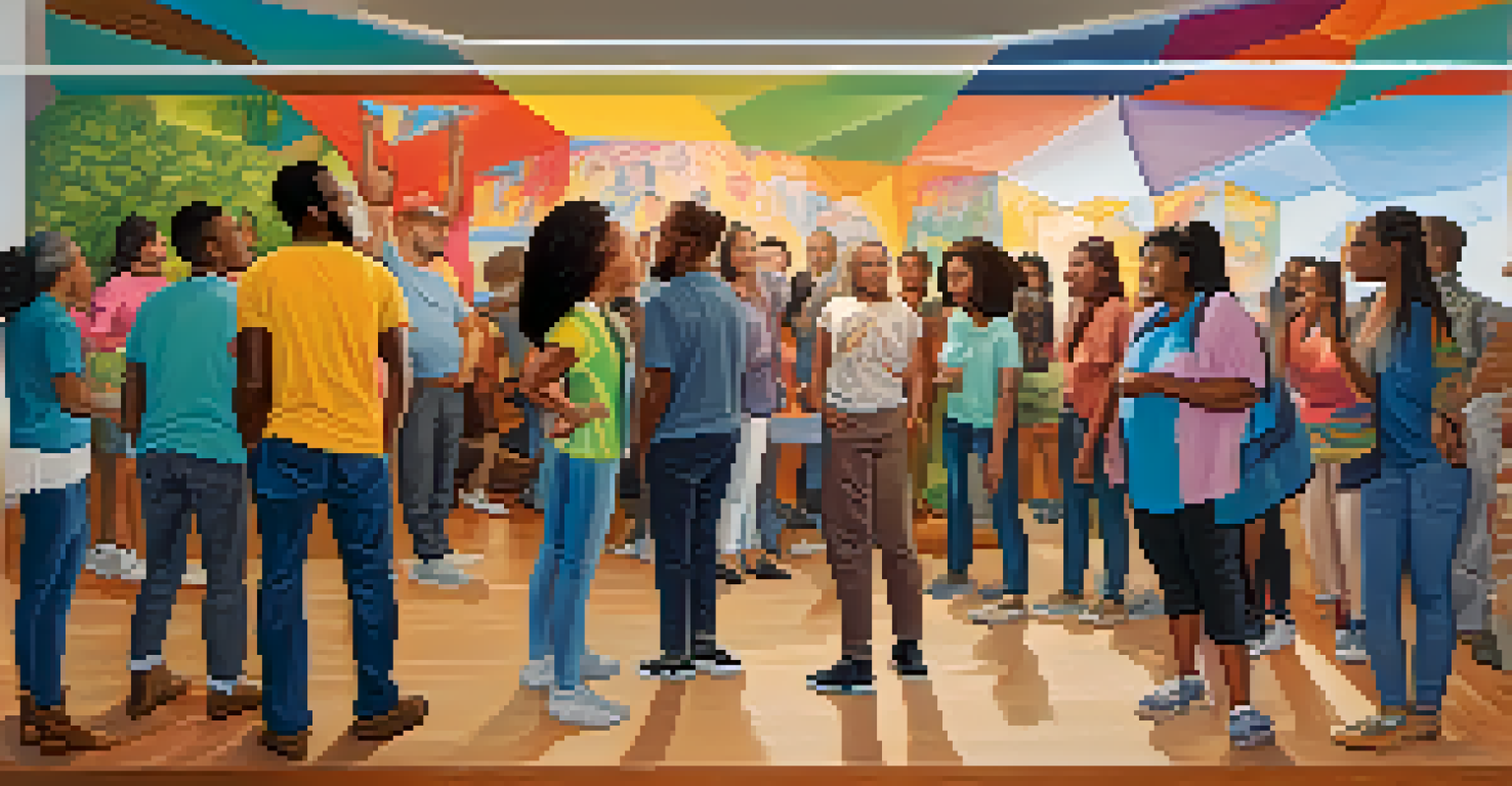Art and Empathy: Ethical Implications of Emotional Expression

Understanding Empathy and Its Role in Art
Empathy is the ability to understand and share the feelings of others, and it's a powerful force in art. When we engage with a painting, a song, or a film, we often find ourselves resonating with the emotions being expressed. This connection can deepen our understanding of different perspectives and experiences, making empathy a vital component of artistic expression.
Art enables us to find ourselves and lose ourselves at the same time.
Art serves as a mirror reflecting the human experience, capturing our joys, sorrows, and everything in between. Through this lens, artists can evoke feelings in their audience that might be hard to access otherwise. For instance, a poignant film about loss can allow viewers to confront their own grief in a safe and relatable way, opening up pathways for healing.
By fostering empathy, art can bridge cultural and social divides, creating a shared space for dialogue. This is especially important in today's fragmented world, where understanding one another is more crucial than ever. As we explore the emotional depths of art, we also begin to embrace the complexities of the human condition.
The Emotional Power of Artistic Expression
Art has an incredible ability to evoke strong emotions; it can make us feel joy, sadness, anger, or nostalgia. This emotional power often stems from the artist's ability to channel their own experiences into their work. When we encounter art that resonates with us, it can feel as though the artist is speaking directly to our own life story.

Consider a powerful song that captures the essence of heartbreak. Many listeners find solace in the lyrics, feeling understood in their pain. This emotional connection not only validates our feelings but can also inspire us to reflect on our own experiences, deepening our empathy towards others who share similar struggles.
Empathy Enhances Artistic Connection
Art fosters empathy by allowing audiences to engage with diverse emotions and experiences, creating deeper connections.
However, this power comes with responsibility. Artists must be aware of the potential impact their work can have on audiences, as it can influence emotions and behaviors. This raises ethical questions about how emotions are portrayed and the messages that are conveyed through various forms of art.
Art as a Tool for Social Change and Empathy
Throughout history, art has been a catalyst for social change, often shining a light on societal issues that require empathy and action. From protest songs to powerful visual art, artists can mobilize public opinion and inspire collective action. This ability to stir emotions can lead to greater awareness and understanding of injustices faced by marginalized communities.
The role of the artist is to make the world a better place by sharing their vision and connecting with others.
For example, street art can transform public spaces into powerful statements about social issues, encouraging viewers to reflect and engage. These visual narratives can evoke empathy and drive home the urgency of the message, prompting individuals to take action or reconsider their perspectives.
By harnessing the emotional power of art, creators can challenge the status quo and inspire audiences to empathize with others' realities. This demonstrates how art can be more than just an aesthetic experience; it can be a potent tool for advocacy and change.
Ethical Considerations in Artistic Representation
While art can foster empathy, it also raises ethical questions about representation. Artists must navigate the line between authentic expression and appropriation, particularly when depicting experiences outside their own. Misrepresentation can perpetuate stereotypes or exploit vulnerable communities, undermining the very empathy art seeks to evoke.
For instance, when artists from privileged backgrounds portray the struggles of marginalized groups, they must approach their work with sensitivity and awareness. It’s essential to engage with those communities, ensuring their voices and stories are represented accurately and respectfully. This collaboration can enhance the authenticity of the artwork while promoting a deeper understanding.
Art as a Catalyst for Social Change
Throughout history, art has inspired social change by highlighting injustices and encouraging public dialogue.
Ultimately, ethical artistic representation is about responsibility. By prioritizing the voices of those directly affected by the issues being depicted, artists can create a more empathetic and honest dialogue around complex social topics.
The Role of Audience in Shaping Artistic Empathy
The audience plays a crucial role in the empathetic experience of art. How we interpret and respond to a piece of art can significantly affect its impact. For instance, viewers who approach a painting with an open mind may find themselves more deeply moved than those who view it through a lens of skepticism or indifference.
When audiences engage with art, they bring their own experiences and emotions into the equation. This personal connection can amplify the empathy evoked by the artwork, allowing for a richer interaction. In this way, the relationship between artist and audience becomes a collaborative journey of emotional exploration.
Moreover, discussions around art can further enhance empathy. Sharing interpretations and reactions with others can open up new perspectives, fostering a community of understanding. By actively engaging with art, audiences can contribute to a broader dialogue about emotions and experiences, enriching the overall impact of the work.
Navigating Emotional Vulnerability in Art
Creating art often requires a level of emotional vulnerability that can be both liberating and daunting. Artists must confront their own feelings and experiences to create work that resonates authentically with others. This vulnerability can foster a deep connection with the audience, as it invites them to share in the artist's journey.
However, this exposure can also raise questions about the ethical implications of sharing personal trauma. Artists must consider how their emotional disclosures may affect their mental health and the potential impact on their audience. Striking a balance between authenticity and self-care is essential for sustainable artistic practice.
Ethics in Artistic Representation
Artists must navigate the ethical implications of representation to ensure authentic and respectful portrayals of diverse experiences.
Ultimately, navigating emotional vulnerability in art is a delicate dance. It requires artists to be mindful of their own limits while remaining open to the powerful connections that can emerge from sharing their truths. By doing so, they can create meaningful work that resonates on a profound level.
The Future of Art and Empathy: Ethical Pathways
As we look to the future, the intersection of art and empathy will continue to evolve, particularly in our increasingly digital world. New technologies provide exciting opportunities for artists to engage with audiences in innovative ways, but they also raise new ethical considerations. For instance, how do we ensure that digital art respects the emotional experiences of those it represents?
Emerging forms of art, such as virtual reality and interactive installations, allow for immersive experiences that can deepen empathy. However, creators must be mindful of their approach, ensuring that they do not exploit the emotions of participants. This thoughtful engagement can lead to transformative experiences that foster understanding and compassion.

By embracing ethical pathways, artists and audiences alike can navigate the complexities of emotional expression in art. As we continue to explore these dynamics, we can cultivate a culture that values empathy and connection, using art as a powerful vehicle for change.